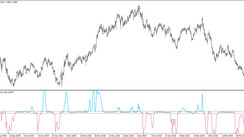Today, market participants will closely follow the ECB press conference, which will begin 30 minutes after the publication (at 12:15 GMT) of the interest rate decision. We already wrote about this in our yesterday's review. It is expected that following this meeting, the key interest rate will be increased by 0.25% (up to -0.25%), and the ECB's rate on deposits for commercial banks - up to 0.25%.
During the press conference, ECB President Christine Lagarde will explain the bank's decision on rates and likely outline the prospects for the central bank's monetary policy in the coming months. You need to be prepared for a sharp increase in volatility during this period of time.
Meanwhile, the US dollar continues to dominate the foreign exchange market, significantly strengthening today against the main commodity currencies: Canadian, Australian, New Zealand dollars. Last week, the NZD hit a new 26-month low against the USD at 0.6060, despite the Reserve Bank of New Zealand raised the official rate (OCR) by 50 bps for the third time in a row last Wednesday, up to 2.5%.
RBNZ officials also decided to keep raising the OCR (official money rate) to a level where they are confident that "consumer price inflation will be within the target range." The RBNZ acknowledged that a sharp rise in consumer prices is possible in the short term, as the situation in the energy market remains highly uncertain (at the moment, the annual inflation rate is 7.3%, which is an absolute maximum in 30 years). Economists predict that by the end of 2022 the RBNZ interest rate could be raised to 3.5%, and to 4% by 2024.
Today, commodity currencies are under pressure from the news that the "Nord Stream 1" gas pipeline has resumed gas supply after 10 days of maintenance. Gas and oil prices are falling today.
On Tuesday, the next 2-week report of the Global Dairy Trade was also published. According to published data, the dairy price index, which reflects the weighted average price changes in percentage terms, again decreased in the previous reporting period and came out with a value of -5.0% (after a decrease of -4.1%, -1.3% in the previous periods).
The economy of New Zealand in many ways still has signs of raw materials. Moreover, the bulk of New Zealand's exports are dairy products and food products of animal origin.
No particularly important economic news in New Zealand is expected this and next week. Therefore, the dynamics of the NZD/USD pair will depend on the general situation on the commodity market and on the dynamics of the US dollar.
As of this writing, DXY futures are traded near 107.10 mark, 87 pips above Wednesday's local intraweek low of 106.23. Given the strong bullish momentum and the long-term DXY uptrend, a breakdown of the local resistance level 109.00 will be a signal to increase long positions in DXY futures "with the prospect of growth towards multi-year highs of 121.29 and 129.05, reached, respectively, in June 2001 and November 1985".






